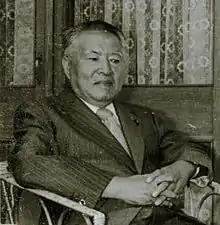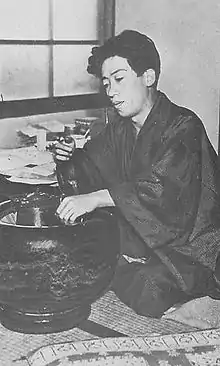Japanese Communist Party
The Japanese Communist Party (JCP; Japanese: 日本共産党, Nihon Kyōsan-tō) is a political party in Japan and is one of the largest non-governing communist parties in the world.
Japanese Communist Party 日本共産党 | |
|---|---|
| Abbreviation | JCP |
| Chairman | Kazuo Shii |
| Secretary-General | Akira Koike[1] |
| Representatives leader | Keiji Kokuta |
| Councillors leader | Yoshiki Yamashita |
| Founded | 15 July 1922[2] |
| Headquarters | 4-26-7 Sendagaya, Shibuya, 151-8586 Japan[3] |
| Newspaper | Shimbun Akahata |
| Youth wing | Democratic Youth League of Japan |
| Membership (2020) | 270,000[4] |
| Ideology | Communism[5] Scientific socialism[6][7] Pacifism[8] Democratic socialism[9] |
| Political position | Left-wing[3][9] to far-left[10][11] |
| Colours | Red[12] |
| Representatives | 12 / 465
|
| Councillors | 13 / 245
|
| Prefectural assembly members[13] | 149 / 2,614
|
| Municipal assembly members[13] | 2,611 / 30,101
|
| Election symbol | |
 | |
| Party flag | |
 | |
| Website | |
| jcp | |



The JCP advocates for the establishment of a society based on socialism, democracy, peace and opposition to militarism. It proposes to achieve its objectives by working within a democratic framework while struggling against what it describes as "imperialism and its subordinate ally, monopoly capital". The party does not advocate violent revolution, instead it proposes a "democratic revolution" to achieve "democratic change in politics and the economy" and "the complete restoration of Japan's national sovereignty", which it sees as infringed by Japan's security alliance with the United States, although it firmly defends Article 9 of the Japanese Constitution due to its opposition of the re-militarization of Japan.
Following the most recent councillors election held on 21 July 2019, the party holds 13 seats in the House of Councillors.[14] Following the most recent general election held on 22 October 2017, the party holds 12 seats in the House of Representatives.
Outline
The JCP is one of the largest non-ruling communist parties in the world, with approximately 270,000 members belonging to 18,000 branches.[15] In the wake of the Sino-Soviet split, the party began to distance itself from the Eastern Bloc, especially from the Soviet Union. After the collapse of the Soviet Union, the JCP released a press statement titled: "We welcome the end of a party which embodied the historical evil of great power chauvinism and hegemonism" (「大国主義・覇権主義の歴史的巨悪の党の終焉を歓迎する」), while at the same time criticizing Eastern European countries for abandoning socialism, describing it as a "reversal of history".[16]
Consequently, the party has not suffered an internal crisis as a result of the collapse of the Soviet Union in 1991, nor has it considered disbanding or changing its name or fundamental objectives, as many other Communist parties have done. It polled 11.3% of the vote in 2000, 8.2% in 2003, 7.3% in 2005, 7.0% in the August 2009 election and 6.2% in 2012. In recent years its support has accrued, but as of the 2014 General Election it won 21 seats, up from eight in the previous general election. The JCP took 7,040,130 votes (13.3%) in the constituency section and 6,062,962 (11.37%) in the party lists. This continues a new wave of support that was also evident in the 2013 Tokyo metropolitan election where the party doubled its representation. Fighting on a platform directly opposed to neoliberalism, the Trans-Pacific Partnership (TPP), attempts to rewrite the constitution, U.S. military bases on Japanese soil and nuclear power, the JCP tapped into a minority current that seeks an alternative to Japan's rightward direction.[17]
Membership
In January 2014, the JCP had approximately 320,000 members. Following the party's advancement in the 2013 Tokyo prefectural election, there had been an increase in membership growth, with over 1,000 people joining in each of the final three months of 2013.[18] Approximately 20% of new members during this period were aged 20–40, showing a higher ratio of young people joining the party than in the past.[18] More recently membership numbers have declined, with membership number around 300,000 in 2017, and 270,000 in 2020.[19][20]
History

The Japanese Communist Party was founded in Tokyo on 15 July 1922.[2] Its early leadership was drawn from the anarcho-syndicalist and Christian socialist movements that developed around the turn of the century. From the former came Yamakawa Hitoshi, Sakai Toshihiko, and Arahata Kanson, who had all been supporters of Kōtoku Shūsui, an anarchist executed in 1911. Katayama Sen, another early leader, had been a Christian socialist for much of his political life. The three former anarchists were reluctant to found the JCP, with Yamakawa shortly after arguing that Japan was not ready for a communist party and calling for work to be done solely within labor unions. Katayama's theoretical understanding of Marxism also remained low.[21]
The JCP was founded as an underground political association. Outlawed in 1925 with the passage of the Peace Preservation Law, the JCP was subjected to repression and persecution by the Special Higher Police (Tokkō), nicknamed the "Thought Police."[22] JCP members and sympathizers were imprisoned and pressured to "convert" (tenkō suru) to anti-communist nationalism.[22] Many of those who refused to convert remained imprisoned for the duration of the Pacific War. The Japanese Communist Party member Hotsumi Ozaki, who was part of the Richard Sorge spy ring for the Kremlin, was the only Japanese person hanged for treason under the Peace Preservation Law.
The Japan Communist Party was legalized in 1945 by the American military occupation of Japan and since then has been a legal political party able to contest elections. In the aftermath of the war, under the guidance of charismatic party chairman Sanzō Nosaka, the party pursued a policy of portraying itself as "lovable."[23] In particular, the party was successful in winning acceptance of the notion that communists had been the only ones to resist Japanese wartime militarism.[22] This propaganda effort won the party thousands of new members and an even larger number of sympathizers, especially among artists and intellectuals.[23]
In 1949, the party made unprecedented gains by winning 10 percent of the vote and sent 35 representatives to the Diet, but early in 1950 the Soviet Union sharply criticized the JCP's parliamentary strategy. Stalin insisted that the JCP pursue more militant, even violent, actions. The Supreme Commander of the Allied Powers (SCAP) seized this occasion to engineer the Red Purge, which forced the party leaders underground. Then after the Korean War broke out, the party adopted the 1951 Platform and staged some acts of terrorism or sabotage, which resulted in a loss of popular confidence.[24][25] Through the end of the decade, it never won more than three percent of the votes or two seats in the Diet. Even so, its strong support among many intellectuals gave it a relatively greater importance than these numbers suggest.
The party did not take sides during the Sino-Soviet split of the 1960s. In the mid-1960s, the United States Department of State estimated the party membership to be approximately 120,000 (0.2% of the working age population).[26] Its politics were independent of the Soviet Union. Reflecting this, its leader from 1958 to 1982, Kenji Miyamoto, opposed the 1968 invasion of Czechoslovakia.
Lam Peng Er argued in Pacific Affairs in 1996 that "the JCP's viability is crucial to the health of Japanese democracy" and says this is because:
It is the only established party in parliament that has not been coopted by the conservative parties. It performs the watchdog role against the ruling parties without fear or favor. More importantly, the JCP often offers the only opposition candidate in prefectural governorship, city mayoral and other local elections. Despite the ostensible differences between the non-Communist parties at the national level, they often support a joint candidate for governor or mayor so that all parties are assured of being part of the ruling coalition. If the JCP did not offer a candidate, there would be a walkover and Japanese voters would be offered a fait accompli without an electoral avenue of protest. Promoting women candidates in elections to win women's votes is another characteristic of the party. More women are elected under the Communist label than other political parties in Japan.[27]
In 2008, foreign media recorded an increase in support for the party due to the effect of the global financial crisis on Japanese workers.[28][29] However, the party failed to increase its number of seats in the 2009 general election. Subsequently, the projected decline of the party was halted, with the JCP becoming the third largest party in the Tokyo Metropolitan Assembly[30][31] and making gains in the House of Councillors, moving from six to 11 seats. They surged forward in the 2014 elections, receiving 7,040,130 votes (13.3%) in the constituency section and 6,062,962 (11.37%) in the party lists.
During the nomination period of the July 2016 House of Councillors election, the party signed an agreement with the Democratic, Social Democratic and People's Life parties to field a jointly-endorsed candidate in each of the 32 districts in which only one seat is contested, uniting in an attempt to take control of the House from the LDP/Komeito coalition.[32] JCP leaders have expressed willingness to enter into a coalition with the Democratic Party, a notion which was rejected by Democratic Party President Katsuya Okada as being "impossible" in the near future due to some of the "extreme leftist policies" promoted by the JCP.[33] The party has three Councillors up for re-election and is fielding a total of 56 candidates in the election, down from 63 candidates in the 2013 election, but still the second-most behind the LDP.[34] However, only 14 of those candidates are contesting single- and multi-member districts, while 42 will contest the 48-seat national proportional representation block.[34]
Policies
One of the JCP's main objectives is terminating the Japan–United States military alliance and the dismantling of all American military bases in Japan.[35] It wants to make Japan a non-aligned and neutral country, in accordance with its principles of self-determination and national sovereignty. There are about 130 American military bases and other related facilities in Japan, with Okinawa having the largest American military base in Asia. The JCP has also traditionally championed pacifism.[36]
With regards to Japan's own military forces, the JCP's current policy is that it is not principally opposed to its existence (in 2000 it decided that it will agree to its use should Japan ever be attacked), but that it will seek to abolish it in the long term, international situation permitting.
The JCP also opposes possession of nuclear weapons by any country or the concept of military blocs and opposes any attempt to revise Article 9 of the Constitution of Japan, which says that "never again [...] [Japan] be visited with the horrors of war through the action of government". Regarding the resolution of disputes, it argues that priority must be given to peaceful means through negotiations, not to military solutions. The JCP says that Japan must adhere to the United Nations Charter.
The JCP has traditionally been opposed to the existence of the Imperial House since the pre-war days. From 2004,[16] it has acknowledged the Emperor as Japan's head of state as long as he remains a figurehead. The JCP has stated that it supports the establishment of a democratic republic, but that "its [the monarchy] continuation or discontinuation should be decided by the will of the majority of the people in future, when the time is ripe to do so".[37] It is also against Japan's use of its national flag and national anthem which it sees as a relic of Japan's militarist past.
The JCP also strives to change the nation's economic policy of what it sees as serving the interests of large corporations and banks to one of "defending the interests of the people," and to establish "democratic rules" that will check the activities of large corporations and "protect the lives and basic rights of the people".
Regarding the issue of the international economy, the JCP has advocated establishing a new international democratic economic order on the basis of respect for the economic sovereignty of each country and strongly opposes the participation to the TPP. The JCP sees the United States, transnational corporations and international financial capital as pushing globalization, which it says is seriously affecting the global economy, including the monetary and financial problems as well as North–South and environmental problems. The JCP advocates "democratic regulation of activities by transnational corporations and international financial capital on an international scale".
In September 2015 after the passage of the 2015 Japanese military legislation, the JCP called for cooperation from other opposition parties to form an interim government to abolish the bills. It was the first time the party had called for such cooperation with other parties.[38][39][40][41]
The JCP supports the legalization of civil unions for same-sex couples.[42] It also advocates for more women in politics and political life.[35]
Foreign policy
The JCP adheres to the idea that Japan as an Asian country must stop putting emphasis on diplomacy centering on relations with the United States and the G8 Summit and put Asian diplomacy at the center of its foreign relations. It supports Japan establishing an "independent foreign policy in the interests of the Japanese people" and rejects "uncritically following any foreign power".
The JCP advocates that Japan issue further apologies for its actions during World War II and has condemned prime-ministerial visits to Yasukuni Shrine.[43] In the 1930s, while the JCP was still illegal, it was the only political party to actively oppose Japan's war with China and World War II. However the JCP supports the territorial claims by Japan in the Kuril and Senkaku Islands and Liancourt Rocks disputes. Furthermore, the JCP has condemned North Korea's nuclear-weapons testing, calling for effective sanctions, but opposing the prospect of a military response.[44]
In 2020, the JCP revised its platform for the first time since 2004. The new platform criticized the Communist Party of China, denouncing China's “great-power chauvinism and hegemonism” as “an adverse current to world peace and progress”. The JCP also removed a line from its platform which described China as a country “that is beginning a new quest for socialism”. JCP members have stated that this was due to human rights conditions in China. The Ministry of Foreign Affairs of China denounced the accusations of the JCP as “groundless and biased”.[45][46]
Organization
Press
Shimbun Akahata (English: Red Flag Newspaper) is the daily organ of the JCP in the form of a national newspaper. Several other newspapers preceded and merged into Red Flag, including Daini Musansha Shinbun (English: The Second Proletarian News), which was merged into Red Flag in 1932.[47] Daini Musansha Shinbun was itself the immediate successor to the original The Proletarian News, which was banned by the government in September 1929.[47] Daini Musansha Shinbun began publication immediately after the ban.[47]
In the past, the party published numerous other newspapers as well, including another national paper called Nihon Seiji Shinbun (English: Japan Political News) and a theoretical journal called Zenshin (English: Forward).[48] The party also published several regional newspapers such as Class War in and around Kyoto, Osaka and Kobe, Shinetsu Red Flag in Nagano and Hokkaido News in Hokkaido.[49] They also published numerous (the exact number is unknown) factory newspapers.[50]
Some regional newspapers, such as Shin Kanagawa (English: New Kanagawa) in Kanagawa, are still published.[51]
Affiliated organizations
The youth wing of JCP is the Democratic Youth League of Japan. In the 1920s and 1930s, the organization published several newspapers of its own, including Rēnin Seinen (English: Lenin Youth) and Proletarian Youth.[47]
The party also has affiliate medical and consumer co-ops.[52] The Japanese Consumers' Co-Operative Union (JCCU), the umbrella body of the co-operative movement in Japan, has a sizable number of communists in its ranks, although the exact numbers are difficult to verify.[52] Another example of the JCP's prevalence in the co-operative movement is the Co-op Kanagawa in the Kanagawa Prefecture, which has 800,000 members and has historical ties to the JCP.[52] It still advertises and occasionally is published in JCP newspapers such as Red Flag and New Kanagawa.[52] The prevalence of house unions in Japan as opposed to enterprise unions has prompted much of the exceptional development of other organizations by the JCP, as well as causing the JCP to seek other external organizational support, including from kōenkai.[52]

The musical group Choir of JCP-fans (JCPファン雑唱団, JCP-fan zassyōdan), was founded in Kyoto in 2011 and directed by Tadao Yamamoto, composer, accordionist, choir director and an ordinary member of the National Council of The Singing Voice of Japan (日本のうたごえ, Nihon no utagoe) / うたごえ運動 Utagoe-undō). As of 2016, the choir is the only organization of Japanese musicians specializing in political support and in the cultural activity of the party, naming itself explicitly by the English official acronym JCP. Its repertory and artistic activity are strongly linked in The Singing Voice of Japan, a musical movement of Japanese working class that dates back to 1948, when the Choir of the Communist Youth League of Japan (日本青年共産同盟中央合唱団, Nihon-seinen-kyōsan-dōmei Chuō-gassyōdan) was established. In various cultural events organized by the party, the Choir of JCP-fans appears as an element among the joined choirs of the volunteer singers of The Singing Voice of Japan.
- Activity of the Choir (some notable concerts and performances)
- 11 February 2011, Kyoto Kaikan Hall: Concert sponsored by the Kyoto Committee of the Japanese Communist Party (JCP).[53]
- 1 August 2013, Nishijin Bunka Center (Kyoto): Cultural Live Revolutionary Pub, in collaboration with Tokiko Nishiyama (西山登紀子), former JCP member of the House of Councilors.[54]
- 23 September 2014, Takaragaike Park (Kyoto): Festival Kyoto ed.2014, organized by the Kyoto Committee of the JCP.[55]
- 1 February 2015, Kyoiku Bunka Center (Kyoto): Festival sponsored by the Kyoto Committee of the JCP.[56]
- 29 April 2016, Takaragaike Park (Kyoto): Festival Kyoto ed.2016, organized by the Kyoto Committee of the JCP: performance with Seifuku Kōjō Iinkai (制服向上委員会) and Akira Koike (小池晃), JCP member of the House of Councilors and Secretary-General of the party.[57][58]
Notable members

Pre-war
Post-war
- Kiyoteru Hanada
- Kenji Miyamoto
- Hiromu Murakami
- Tetsuzo Fuwa
- Kazuo Shii
- Hisashi Inoue
Leaders
| No. | Name | Term of office | |||
|---|---|---|---|---|---|
| Took Office | Left Office | ||||
| General Affairs Chief Secretary | |||||
| 1 | Arahata Katsuzō | 5 July 1922 | 1923 | ||
| 2 | Sakai Toshihiko | 1923 | 1923 | ||
| Party outlawed by the Government | |||||
| General Secretary | |||||
| 1 | Kyuichi Tokuda | 3 December 1945 | 14 October 1953 | ||
| 2 | Sanzō Nosaka | 14 October 1953 | 1 August 1958 | ||
| 3 | Kenji Miyamoto | 1 August 1958 | 7 July 1970 | ||
| Chairperson | |||||
| 1 | Kenji Miyamoto | 7 July 1970 | 31 July 1982 | ||
| 2 | Tetsuzo Fuwa | 31 July 1982 | 29 November 1987 | ||
| 3 | Hiromu Murakami | 29 November 1987 | 29 May 1989 | ||
| (2) | Tetsuzo Fuwa | 29 May 1989 | 24 November 2000 | ||
| 4 | Kazuo Shii | 24 November 2000 | Incumbent | ||
Popular support and electoral results
House of Representatives (Lower House)
Prior to 1996, the entire House of Representatives was elected by majoritarian/"semi-proportional" voting systems with votes cast for individuals (1946: limited voting in multi-member districts, 1947 to 1993 SNTV in multi-member districts). Since 1996, the House of Representatives is elected in a parallel election system – essentially two separate elections only in the lower house complicated by the fact that a candidate may stand in both segments and the sekihairitsu system which ties proportional list ranking to FPTP results: only the majority of members the House of Representatives, 295 (initially 300) seats, are elected in a majoritarian system with voting for candidates (first-past-the-post in single-member districts), while the remaining 180 (initially 200) seats are elected by a proportional representation system (votes are cast for party lists in regional multi-member districts, called "blocks" in the House of Representatives). The votes and vote percentages in the table below are the JCP candidates' vote totals for the whole election from before 1993 and just the votes for the party in the election to the 180 proportional seats after 1996.
| House of Representatives | |||||
| Election year | No. of votes | % of vote | Total seats | ± | Status |
|---|---|---|---|---|---|
| 1946 | 2,135,757 | 3.8 | 6 / 464 |
Opposition | |
| 1947 | 1,002,883 | 3.7 | 4 / 466 |
Opposition | |
| 1949 | 2,984,780 | 9.8 | 35 / 466 |
Opposition | |
| 1952 | 896,765 | 2.5 | 0 / 466 |
Opposition | |
| 1953 | 655,990 | 1.9 | 1 / 466 |
Opposition | |
| 1955 | 733,121 | 2.0 | 2 / 467 |
Opposition | |
| 1958 | 1,012,035 | 2.5 | 1 / 467 |
Opposition | |
| 1960 | 1,156,723 | 2.9 | 3 / 467 |
Opposition | |
| 1963 | 1,646,477 | 4.0 | 5 / 467 |
Opposition | |
| 1967 | 2,190,564 | 4.8 | 5 / 486 |
Opposition | |
| 1969 | 3,199,032 | 6.8 | 14 / 486 |
Opposition | |
| 1972 | 5,496,827 | 10.5 | 38 / 491 |
Opposition | |
| 1976 | 5,878,192 | 10.4 | 17 / 511 |
Opposition | |
| 1979 | 5,625,527 | 10.4 | 39 / 511 |
Opposition | |
| 1980 | 5,803,613 | 9.8 | 29 / 511 |
Opposition | |
| 1983 | 5,302,485 | 9.3 | 26 / 511 |
Opposition | |
| 1986 | 5,313,246 | 8.8 | 26 / 512 |
Opposition | |
| 1990 | 5,226,987 | 8.0 | 16 / 512 |
Opposition | |
| 1993 | 4,834,587 | 7.7 | 15 / 511 |
Opposition | |
| 1996 | 7,268,743 | 13.1 | 26 / 500 |
Opposition | |
| 2000 | 6,719,016 | 11.2 | 20 / 480 |
Opposition | |
| 2003 | 4,586,172 | 7.8 | 9 / 480 |
Opposition | |
| 2005 | 4,919,187 | 7.3 | 9 / 480 |
Opposition | |
| 2009 | 4,943,886 | 7.0 | 9 / 480 |
Opposition | |
| 2012 | 3,689,159 | 6.2 | 8 / 480 |
Opposition | |
| 2014 | 6,062,962 | 11.4 | 21 / 475 |
Opposition | |
| 2017 | 4,404,081 | 7.9 | 12 / 465 |
Opposition | |
House of Councillors (Upper House)
Elections to the House of Councillors are staggered. Every three years, half of the House is up for election to six-year terms. In addition, a parallel election system is used: the majority of members of the House of Councillors (currently 146 of 242, or 73 in one regular election to one half of the House) are elected in 45 (formerly 46→47) prefectural districts, votes are cast for individual candidates by SNTV, but with both multi- and single-member districts used and in the latter SNTV becomes identical to FPTP (winner-takes-all). The remaining, currently 96 members (48 per regular election) are elected in one nationwide district. Until 1980, votes there were cast for individuals too by SNTV. Since 1983, votes are cast for party lists and the seats are allocated proportionally (d'Hondt) in the nationwide district. Unlike in general elections to the lower house, a candidate may not be nominated in both segments of one regular election to the upper house. The seats totals show below are the JCP's overall post-election seat totals, not just their seats elected in that particular year. The votes shown are the votes in the election for the 48 (formerly 50) seats in the nationwide SNTV/PR segment.
| Election year | National district votes | Total | |||
|---|---|---|---|---|---|
| No. of votes | % of votes | Seats | ± | Status | |
| 1947 | 610,948 | 2.9 | 4 / 250 |
Opposition | |
| 1950 | 1,333,872 | 4.8 | 4 / 260 |
Opposition | |
| 1953 | 293,877 | 1.1 | 2 / 260 |
Opposition | |
| 1956 | 599,254 | 2.1 | 2 / 254 |
Opposition | |
| 1959 | 551,916 | 1.9 | 3 / 254 |
Opposition | |
| 1962 | 1,123,947 | 3.1 | 4 / 254 |
Opposition | |
| 1965 | 1,652,364 | 4.4 | 6 / 254 |
Opposition | |
| 1968 | 2,146,879 | 5.0 | 7 / 251 |
Opposition | |
| 1971 | 3,219,307 | 8.1 | 10 / 251 |
Opposition | |
| 1974 | 4,931,650 | 9.4 | 19 / 260 |
Opposition | |
| 1977 | 4,260,050 | 8.4 | 16 / 252 |
Opposition | |
| 1980 | 4,072,019 | 7.3 | 12 / 252 |
Opposition | |
| 1983 | 4,163,877 | 8.9 | 14 / 252 |
Opposition | |
| 1986 | 5,430,838 | 9.5 | 16 / 252 |
Opposition | |
| 1989 | 3,954,408 | 7.0 | 14 / 252 |
Opposition | |
| 1992 | 3,532,956 | 7.9 | 11 / 252 |
Opposition | |
| 1995 | 3,873,955 | 9.5 | 14 / 252 |
Opposition | |
| 1998 | 8,195,078 | 14.6 | 23 / 252 |
Opposition | |
| 2001 | 4,329,210 | 7.9 | 20 / 247 |
Opposition | |
| 2004 | 4,363,107 | 7.8 | 9 / 242 |
Opposition | |
| 2007 | 4,407,937 | 7.5 | 7 / 242 |
Opposition | |
| 2010 | 3,563,556 | 6.1 | 6 / 242 |
Opposition | |
| 2013 | 5,154,055 | 9.7 | 11 / 242 |
Opposition | |
| 2016 | 6,016,245 | 10.7 | 14 / 242 |
Opposition | |
| 2019 | 4,483,411 | 8.95 | 13 / 245 |
Opposition | |
Current Diet members
House of Representatives
|
|
House of Councillors
|
|
See also
- Appeal to the People
- Democracy in Marxism
- Democratic Youth League of Japan
- Japanese dissidence during the early Shōwa period
- List of foreign delegations at the 21st Japanese Communist Party Congress
- List of foreign delegations at the 22nd Japanese Communist Party Congress
- Relations between Japanese Revolutionaries and the Comintern and the Soviet Union
- Socialist thought in Imperial Japan
- Zengakuren
Footnotes
- "JCP elects new leadership" (12 April 2016). "The Japanese Communist Party 5th Central Committee Plenum on 11 April relieved Yamashita Yoshiki (House of Councilors member) of his duty as secretariat head for health reasons and elected Koike Akira (House of Councilors member and currently JCP vice chair) to the position". Retrieved 7 June 2016.
- Uno 1991, p. 1030.
- "Japanese Communist Party". bloomberg.com. Bloomberg L.P. Retrieved 12 June 2019.
- ["http://www.jcp.or.jp/english/2020what_jcp.html"] (2020). Retrieved 29 January 2021.
- Taguchi, Fukuji. 日本大百科全書(ニッポニカ)の解説 [The Nihon Dai Hyakka Zensho: Nipponica 's explanation]. kotobank.jp (in Japanese). The Asahi Shimbun Company. Retrieved 28 October 2020.
- "Japan Working Paper No. 67: The Japanese Communist Party and Its Transformations (in English)". Japan Policy Research Institute. May 2000. Retrieved 4 January 2014.
- "How the Japanese Communist Party Developed its Theory of Scientific Socialism". Japanese Communist Party. Retrieved 12 June 2019.
- "Japan's persistent pacifism (in English)". East Asia Forum. 24 October 2013. Retrieved 4 January 2014.
- "Japanese Communist Party | political party, Japan". Encyclopædia Britannica Online. Retrieved 11 October 2019.
- Willy Jou, Masahisa Endo, ed. (2016). Generational Gap in Japanese Politics: A Longitudinal Study of Political Attitudes and Behaviour. Springer. p. 16. ISBN 9781137503428.
... the conservative end of the ideological spectrum in Japan; second, the JCP, a perennial opposition party located on the far left; third, ...
- "Election campaign, the Japanese way". The Straits Times. 13 June 2017. Retrieved 16 October 2017.
Both the LDP and Kibo no To are in favour of constitutional revision, unlike the new left-leaning Constitutional Democratic Party of Japan and the far-left Japanese Communist Party.
- 日本に定着するか、政党のカラー [Will the colors of political parties settle in Japan?] (in Japanese). Nikkei, Inc. 21 October 2017. Retrieved 29 May 2020.
- Ministry of Internal Affairs and Communications. "Prefectural and local assembly members and governors/mayors by political party as of December 31, 2017" (PDF).
- 'UPPER HOUSE ELECTION 2016'.
The Japan News.
Published 11 July 2016. Retrieved 11 July 2016. - "A Profile of the Japanese Communist Party (2020)". www.jcp.or.jp. Retrieved 29 January 2021.
- The Daily Yomiuri JCP struggling to become relevant July 16 2012 Retrieved on 12 July 2012
- Katz, Phil. "Kinder Scout Trespass commemoration – sponsored fundraiser". www.communist-party.org.uk. Retrieved 27 March 2018.
- "Japanese Communist Party seeing sharp increase in new, young members (in English)". Mainichi Shimbun. 7 January 2014. Archived from the original on 10 January 2014. Retrieved 9 January 2014.
- "A Profile of the Japanese Communist Party 2020". www.jcp.or.jp. Retrieved 29 January 2021.
- "A Profile of the Japanese Communist Party 2017". www.jcp.or.jp. Retrieved 29 January 2021.
- Crooke, Matthew (18 May 2018). "Betraying Revolution: The Foundations of the Japanese Communist Party". Master's Projects and Capstones. Retrieved 25 August 2019.
- Kapur, Nick (10 December 2018). "The Empire Strikes Back? The 1968 Meiji Centennial Celebrations and the Revival of Japanese Nationalism". Japanese Studies. 38 (3): 307.
- Kapur, Nick (2018). Japan at the Crossroads: Conflict and Compromise after Anpo. Cambridge, Massachusetts: Harvard University Press. p. 12.
- Berton, Peter (2000). "JPRI Working Paper No. 67". www.jpri.org. Retrieved 26 July 2020.
- "コミンフォルム批判(コミンフォルムひはん)とは". コトバンク (in Japanese). Retrieved 26 July 2020.
- Benjamin, Roger W.; Kautsky, John H.. Communism and Economic Development, in The American Political Science Review, Vol. 62, No. 1. (March 1968), pp. 122.
- Er, Lam Peng. The Japanese Communist Party: Organization and Resilience in the Midst of Adversity – in Pacific Affairs, Vol. 69, No. 3. (Autumn, 1996), pp. 362–363.
- "Japan's young turn to Communist Party as they decide capitalism has let them down", Daily Telegraph, 18 October 2008.
- "Communism on rise in recession-hit Japan", BBC News, 4 May 2009.
- "JCP book to be published for the first time in South Korea". jcp.or.jp. Retrieved 27 March 2018.
- Dvorak, Phred (21 July 2013). "Japan Communists Celebrate a Little Victory". wsj.com. Retrieved 27 March 2018.
- "Opposition parties, activists ink policy pact for Upper House election". Japan Times. 7 June 2016. Retrieved 23 June 2016.
- Osaki, Tomohiro (21 June 2016). "Abe to 'take responsibility' if ruling bloc fails to win 61 seats in Upper House election". Japan Times. Retrieved 23 June 2016.
- 第3極衰退で候補者減、タレント候補10人に [Fewer candidates with the demise of the third pole – 10 celebrity candidates]. Yomiuri Shimbun (in Japanese). 23 June 2016. Retrieved 23 June 2016.
- Durand, Damien. "Le Japon est-il l'avenir du communisme?".
- "Japan's persistent pacifism (in English)". East Asia Forum. 24 October 2013. Retrieved 4 January 2014.
- "Shii answers reporters' questions on JCP decision to attend opening ceremony of the Diet – @JapanPress_wky". japan-press.co.jp. Retrieved 27 March 2018.
- Shii, Kazuo We Call For Establishing a “National Coalition Government to Repeal the War (Security) Legislation” September 19, 2015 Retrieved 29 September 2015
- JCP proposes establishing a national coalition gov’t to repeal war legislation September 20, 2015 Japan Press Weekly Retrieved 29 September 2015
- JCP seeks cooperation from opposition parties on new security laws September 21, 2015 Japan Times Retrieved 29 September 2015
- Two opposition parties to mull coalition talks with JCP September 28, 2015 Japan Times Retrieved 29 September 2015
- Inada, Miho; Dvorak, Phred. "Same-Sex Marriage in Japan: A Long Way Away?". The Wall Street Journal. 20 September 2013. Retrieved 31 March 2014.
- "JCP Chair Shii comments on Abe's shrine visit". Japanese Communist Party. 26 December 2013. Retrieved 2 April 2014.
- "Shii comments on DPRK nuclear test". Japanese Communist Party. 16 February 2013. 2 April 2014.
- "Japanese Communist Party slams China in first platform change since 2004". The Japan Times Online. 18 January 2020. ISSN 0447-5763. Retrieved 19 February 2020.
- "China's Communist Party a threat to peace, says Japanese counterpart". South China Morning Post. 20 January 2020. Retrieved 19 February 2020.
- Beckmann, G. M. & Genji, O (1969) The Japanese Communist Party 1922–1945, p188
- Beckmann, G. M. & Genji, O (1969) The Japanese Communist Party 1922–1945, p250
- Beckmann, G. M. & Genji, O (1969) The Japanese Communist Party 1922–1945, pp138-139
- Beckmann, G. M. & Genji, O (1969) The Japanese Communist Party 1922–1945, p152
- Lam Peng-Er (1999) Green Politics in Japan, p63
- Lam Peng-Er (1999) Green Politics in Japan, pp62-64
- 「いっぱい花咲かそうコンサート2011」日本共産党京都府委員会 [First performance of the Choir of JCP-fans in a concert Kyoto Kaikan Hall, sponsored by the committee of Kyoto of the JCP.]. Japanese Communist Party.
- 「文化ライブで勝利に貢献 共産・文化後援会が革命酒場」- 京都民報 (in Japanese). 5 August 2013.
- 「2014 京都まつり」- 文化の森 ステージ「にぎわいの広場」日本共産党京都府委員会 (in Japanese). Kyoto Committee of the JCP. 9 September 2014.
- 「いっぱい花咲かそうフェスタ2015」同上 (in Japanese). Kyoto Committee of the JCP. 29 January 2015.
- 「2016 京都まつり」(宝が池公園)。制服向上委員会、小池晃(参議院議員・日本共産党書記局長)共演「2016京都まつり」同上 (in Japanese). Kyoto Committee of the JCP. 2 April 2016.
- 制服向上委員会公式ブログ「2016.04.23 イベント告知」 (in Japanese). Seifuku Kojo Iinkai (SKI). 23 April 2016.
Further reading
- Sen Katayama, The Labor Movement in Japan. Chicago, IL: Charles H. Kerr & Co., 1918.
- Roth, Andrew (1945). Dilemma in Japan. Little, Brown.
- R. Swearingen and P. Langer, Red Flag in Japan: International Communism in Action, 1919–1951. Cambridge, MA: Harvard University Press, 1952.
- T.E. Durkee, The Communist Party of Japan, 1919–1932. PhD dissertation. Stanford University, 1953.
- Robert A. Scalapino, The Japanese Communist Movement: 1920–1966. London: Cambridge University Press. 1967.
- George M. Beckmann and Genji Okubo. The Japanese Communist Party, 1922–1945. Stanford, CA: Stanford University Press, 1969.
- Hong M. Kim, Deradicalization of the Japanese Communist Party Under Kenji Miyamoto. Cambridge University Press, 1976.
- Stephen S. Large, The Romance of Revolution in Japanese Anarchism and Communism during the Taishō Period. Cambridge University Press, 1977.
- G.A. Hoston, Marxism and the Crisis of Development in Prewar Japan. Princeton, NJ: Princeton University Press, 1986.
- Uno, Shun'ichi (1991). Nihon zenshi: Japan chronik (in Japanese). Tokyo: Kodansha Ltd. ISBN 4-06-203994-X.
- Tim Rees and Andrew Thorpe, International Communism and the Communist International, 1919–43. Manchester: Manchester University Press, 1998.
- Louise Young (1999). Japan's Total Empire: Manchuria and the Culture of Wartime Imperialism. University of California Press.
- Sandra Wilson (27 August 2003). The Manchurian Crisis and Japanese Society, 1931–33. Routledge.
- Takemae, Eiji (2003). Allied Occupation of Japan. A&C Black. p. 240.
- Josephine Fowler, Japanese and Chinese Immigrant Activists: Organizing in American and International Communist Movements, 1919–1933. New Brunswick, NJ: Rutgers University Press, 2007.
External links
| Wikimedia Commons has media related to Japanese Communist Party. |
- Official website
- "Anti-Russian Organization Rises in Japan; Red Liaison Officer Says That American Occupation Too Soft". Times Daily. 9 October 1945.
- "Military Oblivion Is Japs' Fate". The Evening Independent. 15 October 1945.
- "Jap Communists Ask United Front Against Shidehara". The Evening Independent. 19 October 1945.
- "Japanese Reds Enjoy Freedom For First Time". Berkeley Daily Gazette. 15 December 1945.
- Members of the Communist Party march and protest in Tokyo (in Japanese). NHK. 27 December 1945.
- Article on Japanese Communist Party from Japanese Press Translations 1945–46. Dartmouth Digital Library Collections.
- "Japanese Communist Party Asks End of Feudal System". Berkeley Daily Gazette. 23 February 1946.
- "5–12 The Red Purge". National Diet Library. Modern Japan Archives. 6 June 1950.
- "Red Parliament Members Fight Purge in Japan". The Owosso Argus-Press. 8 June 1950.
- "Japan's Eight Top Communists Still Missing Without Clue". Reading Eagle. 3 June 1951.
- "The Japanese Communist Party and Its Transformations". Japan Policy Research Institute. May 2000.
- Kazuo Shii: Comments from the Japanese Communist Party on the upcoming election. YouTube video (in English) of the JCP leader Kazuo Shii discussing the 2014 Japanese general election. Uploaded 8 December 2014.